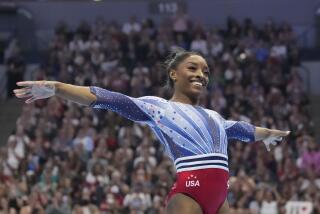Aerialist Cook Mixes In a Large Portion of Courage
- Share via
SAUZE D'OULX, Italy — She may not even be the strongest of two aerials specialists on the U.S. women’s freestyle skiing team, which is not expected to threaten for the gold here at the Winter Olympics.
Inwardly, however, Emily Cook may be the mightiest athlete on the mountain.
The Turin Games have weighed heavily on her mind since she landed awkwardly and shattered both feet while practicing for the 2002 Salt Lake City Games -- injuries that caused her to sit out those Games, and from which she would require more than two years to recover.
During the period between the two Olympics, especially once she was able to ski again, she drew upon courage as well as ability to work back into position to give the Games another try.
Cook declined interview requests Friday and Saturday, politely explaining that she wished to focus entirely on the task at hand: today’s qualifying rounds, which will determine who will advance to Wednesday’s finals.
Perhaps the underlying reason, though, is to avoid being asked to recall, so close to the Olympic competition, the nightmarish incident that occurred in January 2002.
Cook, 27, of Boston, had won a wild-card qualifier to make the team bound for Salt Lake City. She had been jumping well and was brimming with confidence.
But during a training run on a breezy, snowy day at Lake Placid, N.Y., she failed to gather enough speed to reach the downhill slope. She came down upon the flat spot and the impact was so severe that her feet essentially imploded. She suffered multiple fractures, dislocated bones and torn ligaments.
Cook watched the Olympics from a wheelchair, with mixed emotions, cheering a team that included close friend Jeret Peterson of the men’s squad.
At a recent World Cup event in Deer Valley, Utah, Cook told reporters that as she sat watching those Games, her mind’s eye kept wandering ahead to the Turin Olympics.
“There was no question in my mind that I’d come back and compete in another one,” she said. “It was a really long rehabilitation process, but here I am.”
Cook’s first season back on the World Cup circuit was 2004-05.
Her results were mixed: four top-10 finishes with sixth being the best. She was seventh at the 2005 world championships.
“She jumped at Lake Placid, so she put those ghosts behind her, and this season was pretty much normal for her,” said Jeff Wintersteen, coach of the U.S. freestyle team.
“Normal” is a relative term. Cook recalled cringing while watching others getting injured this season at World Cup competitions in China and Australia.
“Whoever gets hurt before you doesn’t want that to affect you,” she said. “You’ve just got to stay focused -- take a deep breath and stay focused. You’ve got to put it out of your mind.”
She has become good at that, she said, explaining that the only thoughts in her mind, as she prepares for each takeoff, are “what I need to do in the air.”
Wintersteen said that in itself shows what kind of athlete she is.
“It definitely takes a special character to get over the fear factor like she has, and it’s not something that goes away easily,” he said.
“And, to keep doing it, you obviously have to love it. Because even when you land well, it’s not a pleasant feeling necessarily. It’s a tough sport. There are a lot of bumps and bruises along the way.”
More to Read
Go beyond the scoreboard
Get the latest on L.A.'s teams in the daily Sports Report newsletter.
You may occasionally receive promotional content from the Los Angeles Times.






